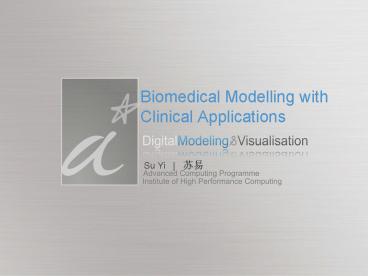Biomedical Modelling with Clinical Applications - PowerPoint PPT Presentation
Title:
Biomedical Modelling with Clinical Applications
Description:
Epidemic of chronic heart failure among survivors of heart attack ... to solving a ray-triangle intersection of a ray with the epicardial surface ... – PowerPoint PPT presentation
Number of Views:50
Avg rating:3.0/5.0
Title: Biomedical Modelling with Clinical Applications
1
Biomedical Modelling with Clinical Applications
Su Yi ??
2
(No Transcript)
3
(No Transcript)
4
From an engineering perspective
Design- centric
5
From a clinical perspective
Patient- centric
6
(No Transcript)
7
An example in dealing with heart failure
- Epidemic of chronic heart failure among survivors
of heart attack
8
What happens after an heart attack?
- LV remodelling the process in which the heart
alters its size, shape configuration after a
heart attack - Serial assessment quantitation of LV
remodelling facilitates - surveillance of heart failure progression
- tailoring of appropriate treatment monitoring
of efficacy - reduce cost
9
How is LV remodelling being assessed?
- Ejection Fraction (EF), i.e. change in LV volume
- Qualitative or semi-quantitative descriptors of
shape, e.g. sphericity index (SI) and conicity
index (CI) - Dimension, e.g. change in LV diameter, wall
thickness image-based - Twisting, e.g. tagged-MRI, speckle tracking
echocardiography image-based - Ventricular wall stiffness (s/e) FEM-based
10
How is LV remodelling being assessed?
- Cardiac magnetic resonance (CMR) imaging
- LV structure and function, e.g. LV dimensions, LV
volumes, etc - Infarct size and extent late gadolinium
enhancement (LGE) - Fails to exploit full range of quantitative
multi-dimensional MRI data
11
Our idea
- To develop new indices to quantitate LV
remodelling using a computational geometry
approach - Extract 3D/4D information
- Provide localised patient-specific details
- Apply rigorous engineering and physiological
principles to derive cardiac indices which are
robust and scientifically valid
12
Our approach
- What kind of clinical inference can we make from
the model?
13
Approximating local shape of LV
14
Extracting physical properties
- Local 3D radius (R)
- Local wall thickness (T) - equivalent to solving
a ray-triangle intersection of a ray with the
epicardial surface - Local wall stress (?)
15
Is 3D method better than 2D image-based methods?
- 10 normal subjects
16
Why is a 3D method better than 2D image-based
methods?
17
Regional curvedness
- 10 control 10 diseased
18
Regional Wall Stress and Thickening
High wall stress, especially at apex
Very little wall thickening despite high wall
stress
19
Validation against LGE
late gadolinium enhancement representing
myocardial scaring/fibrosis
20
Surgical Ventricular Restoration
- 40 patients pre- and post-SVR
Before SVR
4 months after SVR
21
Comparison to other methods
22
What are the implications?
- Potential to replace delayed contrast
hyperenhancement MRI - Reduce scanning time/cost by at least 25
- Avoid the need to inject Gadolinium which might
result in complication in some patients - Reduce patient trauma
23
What are the current limitations?
- Current approach does not exploit full 4D
information finite difference between
end-diastole and end-systole phase - Partitioning of endocardial surface according to
medical nomenclature assumes rigid rotation and
linear vertical compression not realistic - Assumption of uniform pressure loading in LV
chamber
24
Whats needed to bring this to the next level?
- Clinical trial testbedding
- 20 normal
- 30 diseased over time (at least 1 year)
- age-matched
- gender-matched
25
Acceptance by clinicians
- Medical Journals
- Zhong L, Su Y, Yeo SY, Tan RS, Ghista DN, Kassab
G. Three-dimensional curvedness and wall stress
assessment in dilated cardiomyopathy using
magnetic resonance imaging. Am J Physiol Heart
Circ Physiol, 296 H573-H584, 2009. - Yeo SY, Zhong L, Su Y, Tan RS, Ghista DN. A
curvature-based approach for left ventricular
shape analysis from cardiac magnetic resonance
imaging. Med Biol Eng Comput, 47(3) 313-322,
2009. - Invited Book Chapter
- Zhong L, Tan RS, Su Y, Yeo SY, Ghista DN, Kassab
G. Noninvasive Assessment of Left Ventricular
Remodeling Geometry, Wall Stress and Function,
in Computational Cardiovascular Mechanics
Modeling and Applications in Heart Failure,
Julius Guccione and Mark Radcliff, Ed. - Medical Conferences
- L. Zhong, Y. Su, S. Y. Yeo, D. Ghista, R. S. Tan.
Three-dimensional left ventricular regional shape
and wall stress alterations after surgical
ventricular restoration, accepted for oral
presentation at the 11th World Congress on
Medical Physics and Biomedical Engineering,
September 7-12, 2009 in Munich, Germany. - Yeo SY, Zhong L, Su Y, Tan RS, Ghista DN.
Analysis of left ventricular surface deformation
during isovolumic contraction. Conf Proc IEEE Eng
Biol Soc 20071787-790. (EI, PubMed) - Zhong L, Yeo SY, Su Y, Le TT, Tan RS, Ghista DN.
Regional assessment of left ventricular surface
shape from magnetic resonance imaging. Conf Proc
IEEE Eng Biol Soc 20071884-887. (EI, PubMed) - Yeo SY, Tan RS, Chai GB, Ghista DN. Variation of
left ventricular surface shape during the cardiac
cycle. The 3rd IASTED International Conference on
Biomechanics, BioMech 2005. Benidorm, 7-9 Sep
2005.
26
Some concluding thoughts
- Near confluence point of computational and
clinical practitioners - Need appropriate structure to facilitate
communications - Novelty vs Impact
- Ease-of-use is key
27
Thank You































